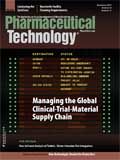Global Healthcare on the Ground: Novartis Focuses on Treating Rare Diseases
Novartis AG and Novartis Pharmaceuticals Corporation have been focusing research efforts on rare diseases since the company was established in 1996.
Novartis AG, headquartered in Basel, Switzerland, and Novartis Pharmaceuticals Corporation headquartered in East Hanover, New Jersey, have been focusing research efforts on rare diseases since the company was established in 1996. The Novartis Institutes for Biomedical Research (NIBR) is a global network consisting of approximately 6000 scientists working across various scientific disciplines around the world. Headquartered in Cambridge, MA, NIBR has offices in Basel, Switzerland; Horsham, UK; Siena Italy; East Hanover, NJ; La Jolla, CA; Emeryville, CA; Forth Worth, TX, and in Singapore and Shanghai.
"Our overarching goal is to help patients," says a company spokesperson. "We do not select research programs based on potential market size, but rather based on unmet medical needs and scientific tractability. In other words, we focus on the patient and follow the science."
This approach has led many of the company's decisions to focus on rare diseases. "What makes these diseases attractive is that they are mechanistically well understood—making tackling the scientific challenges simpler and the development more efficient," adds the company spokesperson. "Additionally, the mechanisms that underlie these diseases are usually shared by more common diseases, so understanding them can shed light on multiple ailments."
What makes rare diseases attractive is that they are mechanistically well understood.
Novartis Pharmaceutical Corporation currently markets 11 products that have been approved by FDA for their orphan designated indication(s), covering a total of 20 orphan indications. The company has 25 approved products that hold orphan designation in the European Union. Here's a look at just a few of them: Afinitor (everolimus), which is used to treat progressive neuroendocrine tumors of pancreatic origin in patients with unresectable, locally advanced, or metastatic disease; Gleevec (imatinib mesylate) tablets are used to treat certain life-threatening cancers; Tasigna (nilotinib) capsules, a signal transduction inhibitor of the BCR-ABL tyrosine kinase, is used to treat patients with a form of chronic myeloid leukemia in chronic and/or accelerated phase patients who are resistant or intolerant to existing treatment options; Ilaris (canakinumab), which is used to treat adults and children aged four years and older suffering from cryopyrin-associated periodic syndrome, a group of rare auto-inflammatory disorders that affect approximately one out of 1 million people worldwide; and Exjade (deferasirox) targets chronic iron overload caused by blood transfusions (transfusional hemosiderosis) in patients 2 years of age and older. Other rare-disease products in the company's pipeline include treatments for myelofibrosis, Cushing's disease, and Fragile X syndrome, which affects one in 5000 children.
NIBR's approach is to focus on the subset of rare disorders that appear mechanistically homogeneous, explains the Novartis spokesperson. "Fundamental mechanisms can predictably be expected to explain subsets of more common disorders, so indication expansion, often based on biomarkers, is expeditious. All drug candidates enter the clinic through small proof-of-concept trials.... We are currently evaluating more than 40 rare diseases, about half in oncology and the remainder across a broad disease spectrum."
Another unique aspect of Novartis' work is that NIBR does not separate out a team, unit, site, or budget dedicated to rare-disease research, says the company's spokesperson. Rather, rare-disease research is central to the company's overall drug discovery approach and threads throughout each component of its work.
Because drug discovery for rare diseases is so complex, Novartis also relies on partnerships. "No one company or organization can possibly do everything on its own," says the company spokesperson. "Therefore, we collaborate with academic institutions and biotechnology companies around the world to work towards the common goal of developing new medicines. These relationships come in varying shapes and sizes."
For example, Novartis is an active member of the joint task force on rare diseases and orphan medicinal products that is run by the European Federation of Pharmaceutical Industries and Associations–European Biopharmaceutical Enterprises and Europa BIO. The company is also involved in Eurordis' roundtable for companies engaged in the orphan drug field. Eurordis is a nongovernmental patient-driven alliance of rare disease patient organizations in Europe. Novartis Pharmaceuticals Corporation is also an active member of the National Organization for Rare Disorders Corporate Council in the US.
Looking ahead, the company says that more funding is crucial to continuing rare-disease research and discovery. "One of the great challenges in drug discovery is finding novel targets, whether they are in rare or common diseases. Much of the fundamental research to find new targets is done by scientists funded by government research grants. Because this process can take decades, it is important that governments maintain or increase funding for basic research," says the spokesperson. "This will ensure that this important work continues."

Pharmaceutical Tariffs Are Imminent: How Industry is Bracing for Impact
April 16th 2025On April 14, 2025, the Trump Administration launched a national security-driven investigation into pharmaceuticals, a move that will likely result in tariffs being placed on pharmaceutical drugs, ingredients, and other components that are imported from outside of the United States.